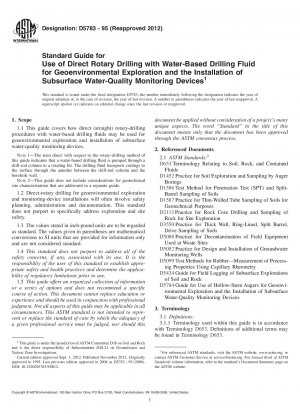ASTM D5783-95(2012)
Standard Guide for Use of Direct Rotary Drilling with Water-Based Drilling Fluid for Geoenvironmental Exploration and the Installation of Subsurface Water-Quality Monitoring Devices
- Standard No.
- ASTM D5783-95(2012)
- Release Date
- 1995
- Published By
- American Society for Testing and Materials (ASTM)
- Status
- Replace By
- ASTM D5783-18
- Latest
- ASTM D5783-18
- Scope
- 1.1 The application of direct-rotary drilling to geoenvironmental exploration may involve sampling, coring, in-situ or pore-fluid testing, or installation of casing for subsequent drilling activities in unconsolidated or consolidated materials. Several advantages of using the direct-rotary drilling method are stability of the borehole wall in drilling unconsolidated formations due to the buildup of a filter cake on the wall. The method can also be used in drilling consolidated formations. Disadvantages to using the direct-rotary drilling method include the introduction of fluids to the subsurface, and creation of the filter cake on the wall of the borehole that may alter the natural hydraulic characteristics of the borehole.
4.2 The subsurface water-quality monitoring devices that are addressed in this guide consist generally of a screened or porous intake and riser pipe(s) that are usually installed with a filter pack to enhance the longevity of the intake unit, and with isolation seals and low-permeability backfill to deter the movement of fluids or infiltration of surface water between hydrologic units penetrated by the borehole (see Practice D5092). Inasmuch as a piezometer is primarily a device used for measuring subsurface hydraulic heads, the conversion of a piezometer to a water-quality monitoring device should be made only after consideration of the overall quality of the installation, including the quality of materials that will contact sampled water or gas.
1.1 This guide covers how direct (straight) rotary-drilling procedures with water-based drilling fluids may be used for geoenvironmental exploration a......
ASTM D5783-95(2012) Referenced Document
- ASTM D1452 Standard Practice for Soil Investigation and Sampling by Auger Borings*, 2000-01-01 Update
- ASTM D1586 Standard Test Method for Penetration Test and Split-Barrel Sampling of Soils*, 1999-04-20 Update
- ASTM D1587 Standard Practice for Thin-Walled Tube Sampling of Soils for Geotechnical Purposes*, 2024-04-20 Update
- ASTM D2113 Standard Practice for Rock Core Drilling and Sampling of Rock for Site Investigation*, 1999-04-20 Update
- ASTM D3550 Standard Practice for Thick Wall, Ring-Lined, Split Barrel, Drive Sampling of Soils
- ASTM D5088 Standard Practice for Decontamination of Field Equipment Used at Nonradioactive Waste Sites*, 2002-01-10 Update
- ASTM D5092 Standard Practice for Design and Installation of Ground Water Monitoring Wells in Aquifers
- ASTM D5099 Standard Test Methods for Rubber-Measurement of Processing Properties Using Capillary Rheometry
- ASTM D5434 Standard Guide for Field Logging of Subsurface Explorations of Soil and Rock*, 1997-04-20 Update
- ASTM D5784 Standard Guide for Use of Hollow-Stem Augers for Geoenvironmental Exploration and the Installation of Subsurface Water-Quality Monitoring Devices
- ASTM D653 Standard Terminology Relating to Soil, Rock, and Contained Fluids*, 1997-04-20 Update
ASTM D5783-95(2012) history
- 2018 ASTM D5783-18 Standard Guide for Use of Direct Rotary Drilling with Water-Based Drilling Fluid for Geoenvironmental Exploration and the Installation of Subsurface Water-Quality Monitoring Devices
- 1995 ASTM D5783-95(2012) Standard Guide for Use of Direct Rotary Drilling with Water-Based Drilling Fluid for Geoenvironmental Exploration and the Installation of Subsurface Water-Quality Monitoring Devices
- 1995 ASTM D5783-95(2006) Standard Guide for Use of Direct Rotary Drilling with Water-Based Drilling Fluid for Geoenvironmental Exploration and the Installation of Subsurface Water-Quality Monitoring Devices
- 1995 ASTM D5783-95(2000) Standard Guide for Use of Direct Rotary Drilling with Water-Based Drilling Fluid for Geoenvironmental Exploration and the Installation of Subsurface Water-Quality Monitoring Devices
